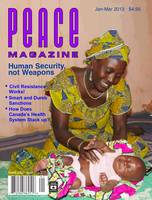
Peace Magazine January-March 2013, page 24. Some rights reserved.
Search for other articles by Smadar Carmon here
A glimpse into occupation
The small village of Susiya in the Israeli Occupied Territories is about to be demolished yet again. But most Canadians have never even heard about the first, second, third and fourth times. But we should know, because Canada is heavily implicated in these human rights abuses as a result of our unconditional support for Israel.
A few years ago some fellow Israelis introduced me to Susiya and its determined and resolute residents. These Israelis have made it their business to work with and support the Palestinians living in the villages of the South Hebron hills.
The elements are harsh in these hills; the scorching heat envelopes you and all you can see is arid land dotted here and there with patches of green. The only lush areas are next to the illegal but fully water-supplied Israeli settlements; while the Palestinians must import and pay dearly for water arriving by truck. Energy is connected for the Jewish settlements, but Palestinian villages have nothing. Recently, my Israeli friends and the Palestinians came up with a way to get power by installing a few small wind turbines and some solar panels. Now at night the residents can read and even use a refrigerator—quite an achievement in the 21st century!
Susiya was razed in 1985, 1991, 1997, and twice in 2001. An adjacent Jewish West Bank settlement of Susiya was built in 1983. In 1986, the Palestinian Susiya was declared an archaeological site as it sits atop remnants of an early Jewish settlement. Its residents were forced to move onto their farmland, into tents and caves. In 2001, the Israeli army (IDF) and Civil Administration, part of the IDF, violently expelled them, destroying their homes, fields, livestock and water cisterns. This was all under the pretense of responding to the second intifada (Palestinian uprising). Following a campaign and legal battle by Palestinian residents and Israeli leftists, the Israeli High Court of Justice instructed authorities to stop the demolitions. But it did not instruct the Civil Administration to allow the Palestinians to build, giving them no other choice but to reconstruct the village without permits.
Throughout the West Bank, East Jerusalem and Gaza, house demolitions are a constant reality for Palestinians. It is estimated that at least 24,813 houses have been demolished since 1967. The Civil Administration routinely discriminates against them by making it their acquisition of building permits almost impossible. Showing the strength and determination they are so recognized for, Susiya residents boldly erected some tents and hovels, including a school.
In spite of the 2001 High Court ruling disallowing further demolitions and other acts of harassment, Jewish settlers and the IDF subjected Palestinian farmers to ongoing violence and blockades of their land. Finally help came from the organization Rabbis for Human Rights; it, along with the residents, filed a complaint regarding their inability to access their land, and the settlers increasing encroachment on it.
In 2011, something unusual occurred: the military commanding officer declared a large part of the Palestinian residents’ land closed to Israelis; this was an attempt to stop the violence and land encroachment by the settlers. To “remedy” this the settlers used the association Regavim to speed up the demolition orders for Susiya’s few meagre structures. Regavim’s petition painted a bizarre picture of the two sides. Palestinian residents became “illegal outpost settlers” (despite the fact that they have lived there for centuries), and Jewish settlers emerged as indigenous, oppressed and discriminated-against (!).
Outrageously, throughout the court challenges and the Regavim petition, the illegal building of the Jewish Susiya continued. As well, the Civil Administration hurried to fly in the face of Israeli law and demolish as much of the Palestinian Susiya as they could before the High Court intervened. On June 13, 2012 they issued demolition orders for 52 buildings, including a preschool, a clinic and a solar panel system.
Susiya is a microcosm of life for Palestinians living under Israeli occupation. The authorities’ obvious discrimination, especially regarding the provision of services, resembles ethnic cleansing. As of today, Palestinians living in the little village of Susiya and elsewhere are under constant threat of demolition, expulsion and forced relocation. It feels like it will never end.
As Canadians we should implore our government to hold Israel to international standards of human rights and not condone their abuses. Let us not leave it to others, such as the current Avaaz petition (avaaz.org/en/petition/ Save_My_Village/?brfxdab&v=15503), to halt the pending Susiya demolitions. We must demand that our government state that this current state of affairs is unacceptable. We should also demand better coverage from our media so that we may learn what is happening in our name.
Smadar Carmon is a human rights activist, raised in Israel, now living in Toronto.

Peace Magazine January-March 2013, page 24. Some rights reserved.
Search for other articles by Smadar Carmon here